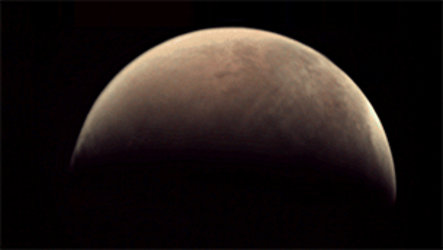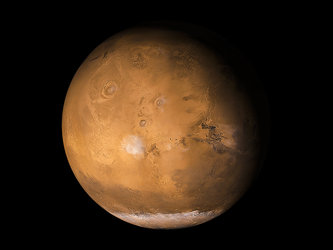The Red Planet
Mars and Earth may be neighbours, but for two planets growing up in the inner Solar System, they certainly evolved very differently into the unique worlds we observe today. But even well into the 20th century, many people believed that Mars could be inhabited just like Earth. Fuelled by interpretations of surface markings as water-filled canals, some serious astronomers as well as science-fiction writers wrote much on the subject of Martians and their civilisation. There were high hopes that even the planet’s seasonal colour changes were signs of growing vegetation. And if there were plants, all manner of other life might be out there.
By mid-century, better telescopes and more careful observation had pretty well ruled out the existence of civilised Martians, but the question remains whether primitive life-forms once existed and if evidence of that remains today.
So it is no surprise that space scientists, mission designers and engineers found Mars an alluring prospect right from the dawn of the space age. Apart from dreams of Martian neighbours, the planet is the most accessible from Earth: at its closest approach, it is less than 60 million kilometres away. A spacecraft in an energy-saving transfer orbit has to follow a much longer, swooping trajectory. Even so, a fairly modest boost will take a probe from Earth orbit to a Mars flyby.

The very first Mars probes were launched by the former Soviet Union in October 1960, only three years after Sputnik. Both failed to reach Earth orbit: ‘accessible’ is relative when dealing with first-generation space technology. But the Russians and their American rivals persevered.
The Americans made the first successful flyby with Mariner-4 in July 1965. Mariner was a technical triumph, but it also brought disappointment. Not only were there no Martians, the surface was a cratered ‘moonscape’ and its ‘vegetation’ turned out to be nothing more than seasonal dust storms.
Later probes, including several landers, brought more news. They found that Mars to be utterly arid, with a whisper-thin atmosphere of 95% carbon dioxide – too tenuous to protect its surface from sterilising ultraviolet radiation. And it is bitterly cold. Even on a midsummer day at the equator, temperatures rarely reach 15°C. On a winter’s night, they fall to around –130°C. As for life: when NASA’s 1976 Viking landers tested the soil for biological activity, they found nothing definite.
But almost 40 years of robotic exploration have revealed a fascinating world of deep valleys and huge, extinct volcanoes, and where ice-crystal clouds sometimes linger in a salmon-pink sky. So the attraction remains. The environment may be inhospitable, but it is far more welcoming than the searing surface of Venus. A Mars day is close to Earth’s 24 hours and today the planet has a similar tilt, so there are seasons and even weather patterns that correspond at least a little to our own. And the question of Martian life is still far from settled.


Access the video
Mars is dry today. But spacecraft photographs – the entire planet has been mapped from orbit – show that water once flowed on its arid surface. There are many etched river valleys and boulder-strewn flood plains that have no other easy explanation. Analysis from orbit and from rover missions have found minerals that form only in the presence of water. Clearly, Mars was once much warmer.
Even if the planet bears no life today, it may have done so in its youth. There may be more than just fossils, too. For years, planetary scientists have been asking: where did all that water go? Much of it probably evaporated into space but there is evidence that some at least is still there, underground. If so, there is a good chance that life has gone underground with it – Earth has plenty of bacteria that could thrive in similar conditions, and life is tenacious.

The search for life is a major element of all present and future Mars missions, including ESA’s Mars Express, which began circling the planet on 25 December 2003, and the ExoMars Trace Gas Orbiter, which arrived in October 2016.
Despite the many missions to Mars, no samples have ever been brought to Earth for analysis. ESA envisages an international Mars sample return mission in collaboration with NASA in the coming decades to collect samples stored by rovers on the surface, blasted into orbit and handed to a spacecraft that will bring a piece of the Red Planet to Earth.
Ultimately, though, Mars exploration plans should result in an even greater adventure: a human mission. Astronauts are vastly more capable than even the smartest robot, but they are also vastly more difficult and expensive to transport. For a human Mars expedition to be possible, new technologies will have to be developed and tested: not only soft-landing methods and fuel processing on the surface, but life-support engineering for a long haul far from home and perhaps entirely new rocket systems, possibly based on new types of propulsion, to reduce the time spent coasting through space.
A crewed mission, perhaps with the Moon as a first target or even as a way station to the Red Planet, would represent the culmination of the programme’s efforts. And it would also guarantee there is life on Mars: human life.














 Germany
Germany
 Austria
Austria
 Belgium
Belgium
 Denmark
Denmark
 Spain
Spain
 Estonia
Estonia
 Finland
Finland
 France
France
 Greece
Greece
 Hungary
Hungary
 Ireland
Ireland
 Italy
Italy
 Luxembourg
Luxembourg
 Norway
Norway
 The Netherlands
The Netherlands
 Poland
Poland
 Portugal
Portugal
 Czechia
Czechia
 Romania
Romania
 United Kingdom
United Kingdom
 Slovenia
Slovenia
 Sweden
Sweden
 Switzerland
Switzerland





























